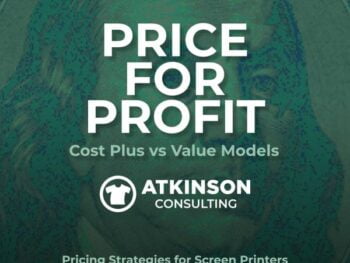Want to make your shop better? Run with more efficiency? Bigger profits at the end of the day? Here is one place you can start. It’s a simple rule and it applies to just about everything:
No bullshit.
Sorry if that is offensive language to you. But I think it is an appropriate business term in our industry context. It sums the collective need to simplify things to push for the greater good. Listed below are six key areas of your business where the NO BS rule could have a tremendous impact. Feel free to add yours in the comments section!
Staffing
Your business isn’t just a line-up of computers, machines and other gizmos. It’s made up essentially by the people you employ. Yet shops all across the land often fail in this most important aspect of their business. They hire the wrong people. They don’t push clear expectations. There isn’t any accountability. They put off employee reviews and difficult conversations.
When it comes down to it, it usually is a leadership challenge. Create a BS Free Zone with how you handle your people.
When you think about your employees or your co-workers does anyone seem extremely out of place or over their head? Get them the help they need or go in another direction in terms of their employment. They don’t “have to” be your employees. That deadweight that’s holding you back can be someone else’s problem. Especially if they have a litany of challenges in their personnel folder.
It should be easy to work in your shop. Clearly defined rules. Crystal clear expectations. Accountability. Trust. Humor. Training. Teamwork. Empathy and understanding. Effort. Reliability. Honesty. Respect. Even fun.
Shops that have this practically run themselves. Shops that don’t look chaotic. Lots of turnover. Dysfunction. Finger pointing and blaming. Mistrust. Basically the opposite of the paragraph above.
If you have ever lamented, “We just can’t find good help!”, often the answer to the challenge starts with the top. Is that you? Look at your own BS and see if you need to change something.
This also may mean that your staff just can’t do what they want. If you have established procedures, policies or rules, then those are the guidelines everyone must follow. If the rules don’t work, by all means change them…but if they are useful and pertinent; then that’s the direction your shop train is traveling.
Either employees are on board, or they need to get off at the next station. That’s No BS.
Craftsmanship
This is crucial. Either you have quality or you don’t. What do you allow to ship?
The No BS rule here would be to clearly define that line. It is binary.
Can you match a PMS color? Can you print or sew in the correct location? Are the garments folded neatly? Is the quality of the decoration perfect? When you put a sticker or shipping packing slip on a box, is it on straight or just slapped on crooked? Details matter.
If your team has any sort of craftsmanship challenges, what are you doing about it? It’s the question for the ages.
Craftsmanship counts.
- Does your shop think craftsmanship is just what happens in production? What about in sales or customer service? How is that mentality driven home in the work they do? The quality of their work affects so many people downstream. When was the last time you had an in-depth review of how orders or information are being used?
- How many customers are lost every year because someone didn’t update the shipping information and the order missed the event? Maybe the info was right, but the shipping label was printed incorrectly.
- How many shops get new business because of dye migration or an under-cured print?
- How many catalog programs are lost each year because your team can’t do an inventory count?
- Take a close look at your art team. How many jobs have to stop from the production floor because something wasn’t digitized properly or separated correctly for printing? If a job on press has to wait so an artist can make a new screen because they don’t like how something prints, that’s a huge problem.
- What happens if that round art is stretched on the shirt because of too much tack? Are you shipping egg shaped prints? Is the last person to see the garments before they go into a box reviewing for quality? Or are you just stuffing them in without a care in the world?
- Can your team load a shirt straight? How many customers complain about crooked or off-center results? This seems like such a basic skill, but you’d be surprised that it is the most common problem out there.
Your shop is the totality of the mistakes you make. You can print 99 orders right, but the only one the customer is going to remember is that one that “got away”. Plenty of shops get new customers all the time because “my old shop screwed up my order”. Have any of your new customers told you that?
Customers have very little memory of past successes.
The NO BS rule changes that. Don’t accept mediocrity. Learn how to do it right. Buy the right equipment. Use it properly. Train your employees. Have good work instructions that clearly define the order expectations. Insist on excellence in every step. All the time.
- Screen-printing: Load the shirt straight, use the correct ink, printed through the right mesh, on tight screens, with the right off contact, with the proper squeegee durometer, at the correct angle, pressure and speed, on a leveled press. Watch your flash dwell times and heat build-up. Remove the shirts from the press without distorting the image. Cure at the right temperature for the ink.
- Embroidery: Hoop it straight, use the correct thread, with the right bobbin tension, sewn with the correct needle size, at the right speed. Trim neatly without cutting a hole in the shirt. Steam out the hoop marks.
- Digital Printing: Load the shirt straight, use the right amount of pretreatment, with the correct print settings. Cure with the right temperature and time.
- Heat Press: Read the instructions for time, temperature and pressure for each type of material used. Place the image on straight. Hot peel and cold peel mean different things. Select your settings accordingly.
Do you cram mistakes in the middle of the shirt pile and hope your customer won’t find them? Do you argue to your wit’s end that your color match is “close”? Are you the master at inventing excuses? That’s all BS and you know it.
Stop sweeping your mistakes under the rug and hoping nobody will notice. They do.
Craftsmanship isn’t about doing just enough to get by. Craftsmanship is all about creating the environment in your shop that pushes the limits of what is the best in the industry. Vince Lombardi has a great quote that applies to this:
“Perfection is not attainable, but if we chase perfection we can catch excellence.”
What level of craftsmanship do you think you have in your shop? Are you working on this every day?
This is shop-wide…not just in production. What are you chasing? Name your top three weakest areas. Start there. That’s no BS.
Lean
From an operational standpoint how efficient is your shop? In manufacturing, lean thinking is all about eliminating waste. Wasted steps and motion are targeted. A hypothesis is developed for the change. It’s tested. Implemented, and then constantly tweaked.
Are you on a continuous improvement journey?
Apply a No BS rule to your operational efficiency. Take a long, hard look at the internal processes in your shop. Just in how things are routed, organized and handled. What sticks out? Look for your bottlenecks. Talk to your staff. What are their biggest problems?
Within each task that has to be accomplished, you might go from A to B to C to D to E to F. Map it out. Gather your team together and examine the process. What do you need to eliminate a step or two? Do you do something in your shop just because “that’s the way it’s always been done”?
There may be a better way. Think about these things in your shop that are slowing you down:
- Does each workgroup have all the tools they need? Does a printer have to go and search for a PMS book to review the ink match? Does a catcher have to go hunt down a tape gun just to close a box? What if each workgroup had a complete set of everything needed so nobody had to share? Don’t step over a dollar to save a dime. The expense of buying something can be little compared the every day labor you are spending in doing without.
- How can technology impact your shop? Can you use automation to send out art approvals? Coat screens consistently? Import order information? Handle communication? Schedule jobs? Gather information?
- Preventative maintenance for your equipment. Do you have machines that are down? How often is your equipment maintained? You are only making money when your machines are running. Downtime = Zero Cash Flow. Sadly, even though shops spend a boatload of money on the equipment for the shops, very few of them even read the owners manuals. It’s just work, work, work, work until the machine breaks. Then, it’s the equipment’s fault. Take care of the things that matter. Yes, that means you.
- Using the wrong information to make decisions? How is information communicated in your shop?
- In receiving, do they know what goods are coming in so they can check against the packing list? This is for everything that is coming in the door.
- In the art department, do you have design changes due to lack of information or good instructions? Sales teams or CSR’s often give sparse info and just leave it to the art team to figure it out. What type of time suck do you think that creates?
- In the screen room, are the mesh counts assigned to colors for the job by the art department? They should. When the art team has screen mesh count knowledge they can make better decisions with the technical end of creativity. If your team doesn’t have this, get them the training. A simple guideline is a place to start.
- In production, are the job details for ink, thread, placement, shirt color, quantity by size, and any other details listed on the order instructions? Does anyone have to stop and ask what to do for the job prior to setting it up?
- Are shipping details perfect so orders can go smoothly through the system and out the door? What if something changes during the production run? How does your shop ensure that the job will ship correctly?
The goal of lean in your shop is to establish standards for work to eliminate any waste. What BS is the way? Old rules? Junk nobody uses? Barely functional equipment? Spend-thrift decisions about supplies? Personnel issues? Clutter everywhere?
Get past that and work towards freeing up time and effort by culling out the problems that don’t work to increase operational efficiency. Some of this effort will be easy. Some of it may require a difficult conversation.
Compromise
For a lot of things a compromise will be reached to satisfy many different concerns or a group of people. A new vacation policy for example. Compromise in this context is great and truly needed.
Where the No BS rule comes into play for compromise is in bigger picture ideas. Your company’s Vision Statement. Core Values. Purpose.
When you think about your shop are you doing what you set out to do? For a lot of companies they work for a few years and realize that they left a lot of the “why” they got into the business at the feet of getting another order.
- What is the Vision Statement for your company? Do you even have one? Have you ever described the overall macro view of your company to your employees? What do they think your company should be doing?
- What are the Core Values of your company? Can you list them? Do you have them written on a plaque on the wall, or posted on your website?
- What is the Purpose of your company? Your main mission is to what?
There is a reason I’m asking. I’ve had plenty of in-depth conversations with shop owners about their businesses. For many, their core beliefs and ideals that they founded the company with aren’t present in their daily view. They’ve sacrificed and ignored some of their principles. Now, years later they are mystified about how they are running their own businesses.
It’s heavy.
Here’s the NO BS rule though. You have to paint the picture about these important things everyday in order for them to be present. What is your Vision? What are your Core Values? What is the Purpose of your company?
If you want your team to follow these maxims and use them to guide their actions and business decisions you have to talk about them constantly. They just can’t be on a plaque on the wall or posted on your website.
They need to be in the heart, lungs and breath of your company. Your leadership must instill these in the actions they choose to take every day. You need to acknowledge or even reward staff members who demonstrate that they “get it”. Conversely, you need to eliminate those that don’t.
There shouldn’t be any compromise on this big picture, and crucial ideals. That’s No BS.
Creativity & Learning
What separates the wheat from the chaff in this industry? It’s simple. The masters of our craft are constantly learning and pushing the envelope with their creativity. The best shops all pressure themselves to get better.
In everything.
What have you done this week to learn something new? Are you asking your staff to experiment with anything? Do you:
- Constantly scour industry trade magazine for tips and ideas? Then, you try out something or use what’s written to develop your own take on the subject matter. You are steering your own boat in the sea of knowledge.
- Fail? By fail, I mean try to do something and not worry about if it succeeds or not. Have you given your staff permission to try new things and not worry about the outcome? Part of the journey of learning is to try. Nobody learns to ride a bike, ice skate or cook French food without disastrous first attempts. They same can be said of puff-embroidery, using foil, four color process printing, or maybe some type of multi-media effort. Be fearless.
- Celebrate learning? Do you talk about big ideas? Discuss that book that someone just read? Pass around the latest TEDtalk? Listen to podcasts instead of music? Subscribe to blogs (hey, like this one!) or newsfeeds? If your team isn’t searching for new inputs, don’t be surprised when everything constantly stays the same.
This isn’t just with your management team. This is with everybody. When you celebrate creativity and learning you are opening up the floor to new ideas. You are saying “It’s ok to try something new”. That’s where the real growth occurs.
Do you want to be just a group of order processors? Where’s the fun in that?
This industry is a marathon, not a sprint. In order to really succeed you have to separate your shop from all the look-a-likes. There is a low cost of entry into this business. Anyone can embroider or print a shirt. Not everyone can do it well. Few can stump the experts.
When your work stands alone as a shining example of the best the industry has to offer, you won’t be competing any longer on price. Creativity drives value. Learning to do it better drives value.
That’s the No BS rule here. Increase your value.
Plan
Have you ever read or heard this before?
“Failure to plan is planning to fail?”
I’m only asking because one of the top challenges that I see with the shops I’m talking to daily is that a good number don’t have any sort of long-range plan for their business.
They’ve started it. Worked it for a few years. Seen some great growth. Now, they are poised to take the next step and blossom. Everything that they’ve accomplished as been due to hard work and a good amount of luck.
I say that because there are just as many shops that didn’t quite make it. Where do you think all the used equipment on the market comes from? They worked just as hard. Except that they were in the wrong area, or tried to service the wrong market. Or any number of things really. For them, their Ready, Fire, Aim luck didn’t work out so well.
Want to push for better growth and fantastic success? The only way to do that is to plan for it. It is the long-range mental game. It is strategic. It is No BS planning.
One of the first things I ask for when I start coaching shops is for them to send me their current business plan. About 75% of the shops that I’m working with don’t have one, or the one they have is several years old and doesn’t match up to their current state.
Why do you need one anyway? Can’t you just wing it? It’s been working good so far…
Here’s why. Let’s say you want to drive from Miami to San Francisco. Would you just get in your car and drive? What roads would you take? Where are you stopping to rest or sleep? Is there anything you’d like to see along the way?
I’m sure plenty of people could find their way without planning the trip, but constructing a plan would bring a long list of benefits that would help on the journey.
Writing a business plan works the same way. Can you just shoot from the hip? Sure. But knowing your direction, key landmarks, understanding your metrics, challenges, competition, and most importantly your customers, is the No BS way to get to the next level.
Success is strategic in nature.
Don’t have a current business plan? There is a wonderful free template available at the Small Business Administration. Click here to use it. Here’s what you will need to write:
- Executive Summary – this is a brief overview of your business. It lists your company information, products or services you sell, your audience, ideal customer, and the future of your business in the industry.
- Company Description. Details about your company. Your key staff members, such as your CEO, President or other executives. List your Mission Statement. Describe the qualities that makes your shop a success.
- Market Research. This is an overview of your customer demographic. Do you have a solid understanding of the marketplace? Who is your target customer? Provide a competitive analysis of how other businesses are targeting these customers. What legal requirements are impacting your industry at the local, state and federal level?
- Product or Services. Provide in detail the product or services you are marketing to your customers. Explain the benefits, the advantages you have over your competition, any any future developments that you may employ to gain a better market share. In a nutshell, why should they buy from you?
- Marketing & Sales. Describe in depth how your company focuses on your customers through your marketing and sales efforts. How do you reach your customers? What are your companies’ growth strategies? How does your company communicate with your customers or potential customers? How do you advertise? How will you know your marketing efforts are effective?
- Financial Projections. Provide financial information. Spreadsheets should include: Profit and Loss Projection, Cash Flow Projection, Projected Balance Sheet, and your Break-even Analysis.
Here’s the No BS…to grow your business you have to understand your journey. Where you’ve been. Where you are going. Can you describe where your shop will be in 3 years? 5 years? Maybe 10?
If so, that’s great! If not, it looks like you have some homework to do.
…and it’s N0 BS.
.
“Strategic planning is worthless – unless there is first a strategic vision.” – John Naisbitt
“Everyone has a plan until they get punched in the mouth.” – Mike Tyson
“Stop setting goals. Goals are pure fantasy unless you have a specific plan to achieve them.” – Stephen Covey
I’d Love to Coach You
Want to learn how I can help you with your business? Let’s connect! Reach out to me and let’s get started today!
[contact-form][contact-field label=”Name” type=”name” required=”true” /][contact-field label=”Email” type=”email” required=”true” /][contact-field label=”Website” type=”url” /][contact-field label=”Message” type=”textarea” /][/contact-form]






1 comment